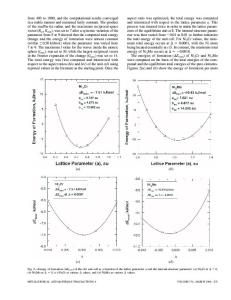Novel as-cast AlCrFe 2 Ni 2 Ti 05 high-entropy alloy with excellent mechanical properties
- PDF / 628,687 Bytes
- 6 Pages / 592.8 x 841.98 pts Page_size
- 68 Downloads / 358 Views
Novel as-cast AlCrFe2Ni2Ti0.5 high-entropy alloy with excellent mechanical properties Cheng-bin Wei 1), Xing-hao Du 2), Yi-ping Lu 1), Hui Jiang 3), Ting-ju Li 1), and Tong-min Wang 1) 1) Key Laboratory of Solidification Control and Digital Preparation Technology (Liaoning Province), School of Materials Science and Engineering, Dalian University of Technology, Dalian 116024, China 2) School of Materials Science and Engineering, Shenyang Aerospace University, Shenyang 110136, China 3) College of Mechanical and Electronic Engineering, Shandong University of Science and Technology, Qingdao 266590, China (Received: 31 October 2019; revised: 9 March 2020; accepted: 12 March 2020)
Abstract: We designed a novel Co-free AlCrFe2Ni2Ti0.5 high-entropy alloy (HEA) that features an excellent combination of strength and ductility in this study. The as-cast AlCrFe2Ni2Ti0.5 alloy showed equiaxed grains undergoing spinodal decomposition, which consisted of ultrafine-grained laminated body-centered cubic (bcc) phases and an ordered body-centered cubic (b2) phase, and some precipitates embedded in the b2 matrix. The bcc and b2 phases also feature a coherent interface. This unique structure impedes mobile dislocations and hinders the formation of cracks, thereby giving the AlCrFe2Ni2Ti0.5 HEA both high strength and plasticity. At room temperature, the as-cast AlCrFe2Ni2Ti0.5 alloy exhibited a compressive yield strength of 1714 MPa, an ultimate strength of 3307 MPa, and an elongation of 43%. These mechanical properties are superior to those of most reported HEAs. Keywords: high-entropy alloys; mechanical properties; coherent interface; spinodal structure
1. Introduction Recently, the new class of alloys known as high-entropy alloys (HEAs) [1] or multicomponent alloys [2] has attracted much attention due to their excellent mechanical properties [3–7], superior radiation tolerance [8], superconductivity [9], unique magnetic properties [10], high thermal stability [11], high oxidation resistance [12], superior corrosion resistance of single-phase-structure HEAs [13], and dual phase nanostructures [14]. Over the past decade, the microstructure and properties of many HEAs have been studied and characterized, and researchers have found that HEAs with a single-phase structure have difficulty achieving a reasonable balance between strength and ductility. Typically, single face-centered cubic (fcc)-structured HEAs have high ductility [15], whereas single body-centered cubic (bcc)-structured HEAs have high strength but poor ductility [16]. Not all the alloys with multiple elements and equi- or unequi-atomic ratio compositions can form HEA solid solutions [17]. To date, many authors have developed phase formation rules for HEAs. Zhang et al. [18] proposed a cri
terion for achieving solid-solution phases based on the mixing enthalpy, mixing entropy, and mean square of the atomic radius difference. The authors noted that mixing enthalpy, mixing entropy, and mean
Data Loading...











